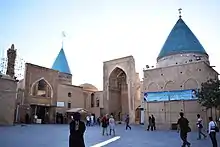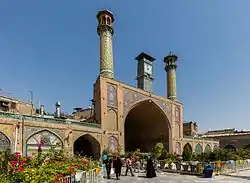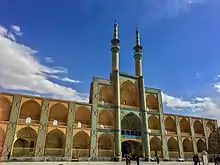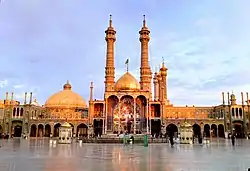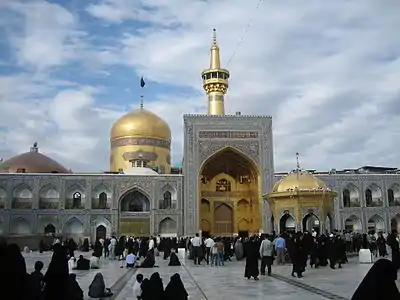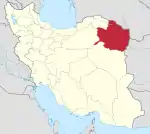Goharshad Mosque
Goharshad Mosque (Persian: مسجد گوهرشاد) is a grand congregational mosque built during the Timurid period in Mashhad, Razavi Khorasan Province, Iran, which now serves as one of the prayer halls within the Imam Reza shrine complex.
| Goharshad Mosque | |
|---|---|
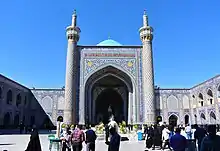 The monumental "Maqsura" Iwan along with the dome and minarets of Goharshad Mosque. | |
| Religion | |
| Affiliation | Shia |
| Location | |
| Location | Mashhad, Razavi Khorasan Province, Iran |
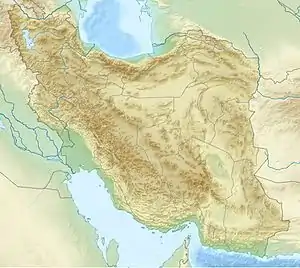 Shown within Iran | |
| Administration | Astan Quds Razavi |
| Geographic coordinates | |
| Architecture | |
| Architect(s) | Ghavameddin Shirazi |
| Type | Jameh Mosque |
| Style | Timurid Style |
| Founder | Empress Goharshad |
| Completed | 1394-1395 |
| Specifications | |
| Dome(s) | 1 |
| Dome height (outer) | 43 meters |
| Minaret(s) | 2 |
| Minaret height | 43 meters |
History
It was built by the order of Empress Goharshad, the wife of Shah Rukh of the Timurid dynasty in 1418 CE. The architect of the edifice was Ghavameddin Shirazi, who is responsible for so many of Shah Rukh's great buildings, with the architectural and decorative manpower supplied from Shiraz and Isfahan.
The mosque underwent some renovations during the Safavid and Qajar eras. It has four iwans and a courtyard measuring 50 m × 55 m (164 ft × 180 ft), as well as several shabestans. Various inscriptions found on mosaic tile work inside the mosque and its courtyard mention the names of Safavid shahs such as Shah Abbas, Shah Soltan Hussayn, Shah Soleyman Safavid and describe their devotion to the Shrine and the contributions they made to the mosque.
The double-layered dome of the mosque was severely damaged in 1911 in bombings by troops of the Russian Empire. In the 1960s, over 5 centuries after its initial construction, the dome of Goharshad mosque was deemed to be in severe structural danger, damages caused by various earthquakes over time, the 1911 Russian bombings, and the attack on the mosque by Reza Shah during the 1935 rebellion required the dome to be rebuilt. Under the imperial orders of Mohammad Reza Pahlavi, the tiles from the ancient dome were removed in the 1960s and the external shell was dismantled. In order to address the structural dangers, a new external shell was built with an iron frame and cement covering. The dome was then re-tiled, in a similar fashion to the original. While such repairs were necessary, they permanently altered the historic identity of the mosque.
In the 1960s, the mosque's eastern iwan also received restoration work. It was pulled down to the foundations and rebuilt from concrete in the same aesthetic style as the original.
Following the event of the 1979 Islamic Revolution, expansions were planned for the entirety of the Shrine complex, a new courtyard named "Sahn-e-Qods" was added on to the back side of Gowharshad mosque, where the historic bazaar once had led up to.
Design
The first and the greatest surviving, Persian monument of the fifteenth century is the beautiful mosque of Gawhar Shad (1418) now abutting the shrine of the Imam Reza in Mashhad. Its portal continues the Samarkand style of arch within arch, enriched by a succession of bevels and reveals that give it depth and power. The thick, tower-like minarets, merging with the outer corners of the portal screen, extend to the ground and, together with the high foundation revetment of marble, give the ensemble the impression of solidity necessary to support its exuberant color. The entire court facade is faced with enamel brick and mosaic faience of the finest quality.
The full scale of colors includes a dominant cobalt blue and turquoise, white, a transparent green, yellow, saffron, aubergine and mirrorblack – all tones fluctuating through several shades. The patterns lucid and vigorous, are artfully adapted to their decorative role, whether for eye-panels, or dome ornament meant to be effective at a thousand feet.
Monotony, difficult to avoid in such a large area, and a distracting intricacy that might compete with the essential architectural forms are both forestalled.
This is accomplished by the energy of the faience floral patterns and brick geometrical schemes; by the emphatic rhythm of the arcades, open galleries and deep recesses; and especially by the contrast of the ivans.
References
- Upham Pope, Arthur (1965). Persian Architecture: The Triumph of Form and Color. New York. ISBN 978-0-8076-0308-6.
External links
![]() Media related to Goharshad Mosque at Wikimedia Commons
Media related to Goharshad Mosque at Wikimedia Commons
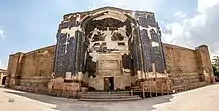
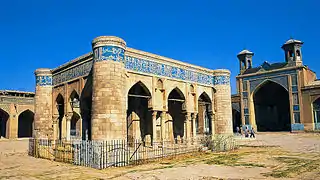
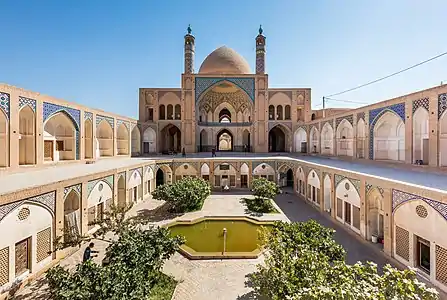

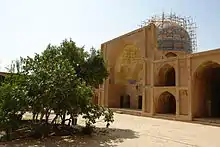
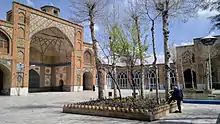
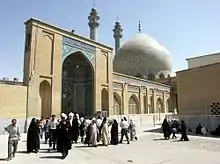
%252C_2014.JPG.webp)
